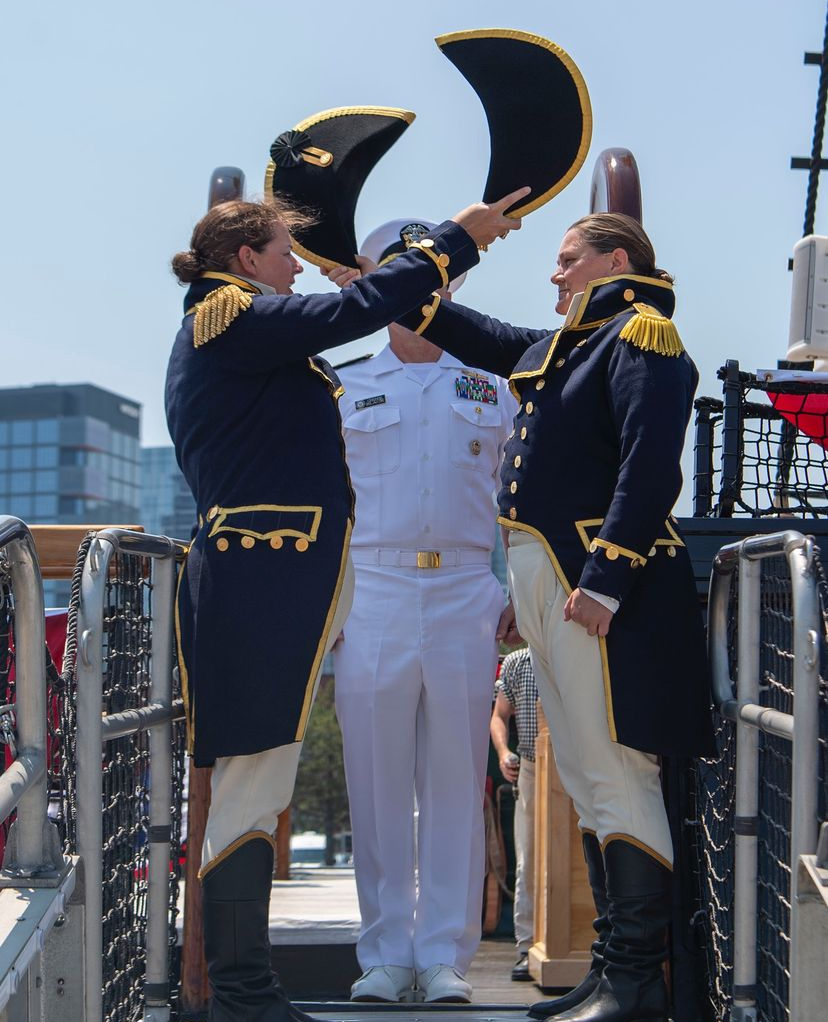Men dominated shipboard life during the Age of Sail, and men comprised the entirety of USS Constitution‘s crew until 1986. However, women frequently sailed on and visited Constitution throughout the ship’s active sailing career in the 19th century, and hundreds have served on Constitution since 1986.
Crew Families
British naval tradition allowed some crew members’ wives on board, and U.S. Navy ships likewise accepted the presence of women as passengers at times. Women and children, usually the family of officers and diplomats, sometimes stepped aboard USS Constitution for transport from one location to another. At least one woman even gave birth on board in 1849 (more on that below).
During the First Barbary War from 1803 to 1805, at least one warrant officer’s wife sailed on board Constitution. Boatswain John Newton Cannon’s wife, Ann, accompanied him when he transferred to Constitution from USS New York in Gibraltar in 1803. Records suggest Ann stayed at sea with her husband until his dismissal from service in 1806. Evidence from other U.S. Navy ships during the conflict suggest the presence of other wives on other ships.
Warrant officers held specifically skilled positions that allowed for certain privileges. Positions like the boatswain, sailmaker, and carpenter generally did not stand watch, and for that reason, the Navy commonly allowed those particular officers’ wives on board. This practice began in the British Royal Navy and extended to early U.S. Navy ships. At least five such women sailed on USS Chesapeake during the First Barbary War, along with the commodore’s wife. A midshipman’s account of one of the wives giving birth on board Chesapeake in 1803 referred to the other wives getting drunk to celebrate in their quarters, a canvas-partitioned cabin at the forward end of the berth deck that was separate from the rest of the enlisted crew.1
Neither the muster rolls nor the ship’s logbooks officially recorded when wives were aboard, making it difficult to accurately determine how many sailed or how frequently. Evidence of their presence shows up only in individual accounts or circumstances, such as the birth on Chesapeake. In the case of Boatswain Cannon on Constitution in 1803, the surgeon and captain noted the presence of Cannon’s wife, Ann, in their reports documenting his six months on the sick list due to syphilis.
Passengers
Despite its status as a warship, USS Constitution frequently transported diplomatic passengers and their families, particularly during the ship’s years of squadron duty in the Mediterranean during the 1820s and 1830s.
In 1824, Charles D. Coxe, his wife Fortuna, and their daughter, Rebecca, boarded Constitution in New York for the long voyage to Tunisia, where Charles would serve as U.S. consul. By that point, Fortuna was likely used to such travel. She was also the daughter of a U.S. consul and had married Charles in Malta in 1811.
Over two decades later, in 1849, Constitution transported Daniel Smith McCauley, his wife, Frances Ann, and their children from Tunisia to Alexandria, where Daniel would serve as the first American Consul General to Egypt. Before the ship could be piloted into the Port of Alexandria, Frances Ann gave birth to a son, named Constitution Stewart McCauley.
Just before departing on an underway cruise in 1971, USS Constitution‘s crew removed a female newspaper reporter named Ruby Litinsky, who boarded the ship disguised as a male reporter. At the time, Constitution‘s underway cruises in Boston Harbor were limited to male passengers only. Many newspaper headlines covering the event referenced the popular notion that the presence of woman on board ships brought bad luck, or highlighted the Navy’s insistence on adhering to that tradition. This left the incorrect impression that women never sailed on U.S. Navy ships. In fact, these restrictions only began in the 20th century. Following the national news spurred by Litinsky’s removal, the Navy reconsidered its exclusion of female passengers. The next year, the Navy invited women on board USS Constitution‘s underway cruises.
Modern Crew
Today, about one third of USS Constitution‘s active-duty crew is comprised of women, ranging from newly enlisted seamen to lieutenants and commanding officers. Rosemarie Lanam became the first enlisted woman to join USS Constitution‘s crew in 1986. Ten years later, Lieutenant Commander Claire V. Bloom became the first female commissioned officer to serve on Constitution in 1996. Twenty six years after that, Commander Billie June Farrell became Constitution‘s first female commanding officer in 2022. In 2024, Farrell turned over command to the second female commanding officer in the ship’s over 200-year history, Commander Crystal L. Schaefer.

___________________________
1 Michael J. Crawford, Officers of Peculiar Skill Petty and Forward Officers of the U.S. Navy, 1797–1860 (Washington, D.C: Naval History and Heritage Command, 2019), 45.
Robin Laurinec contributed research for this article.
The Author(s)
Carl Herzog
Public Historian, USS Constitution Museum
Carl Herzog is the Public Historian at the USS Constitution Museum.